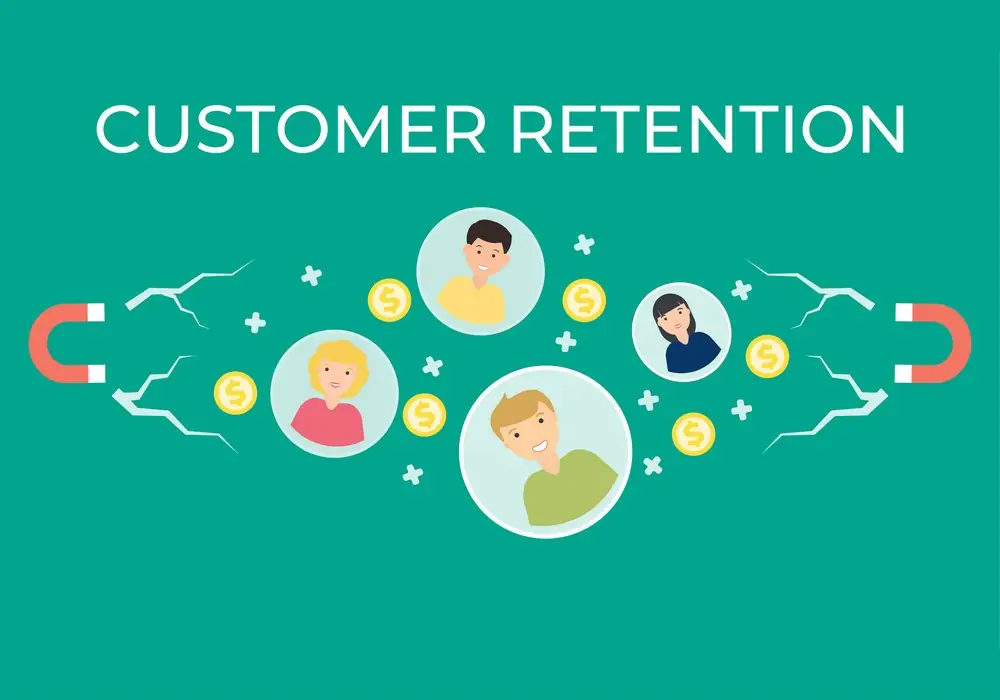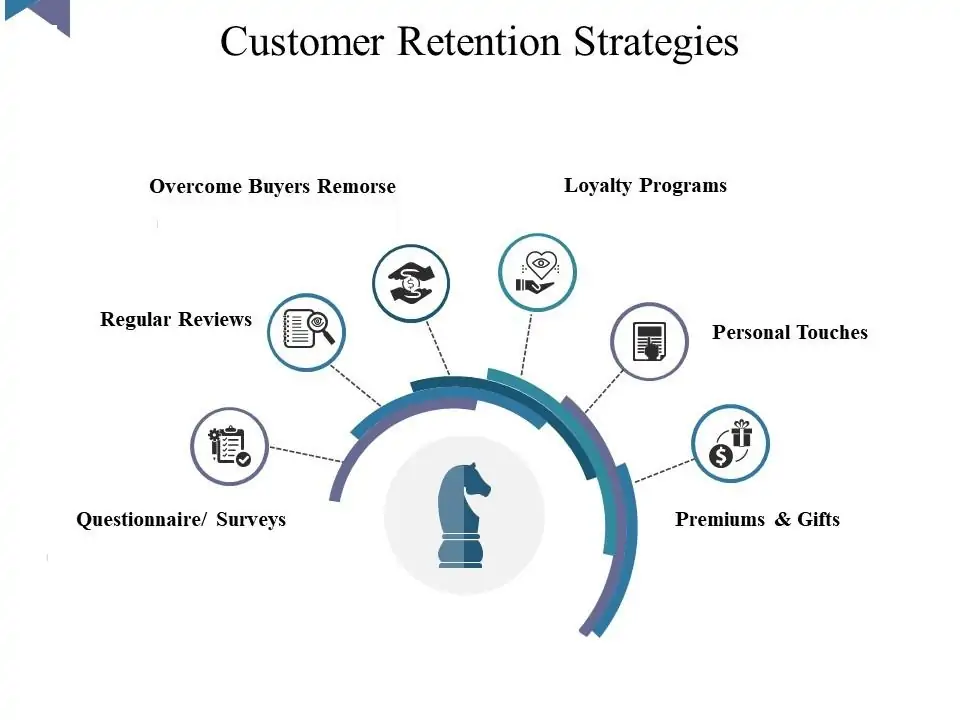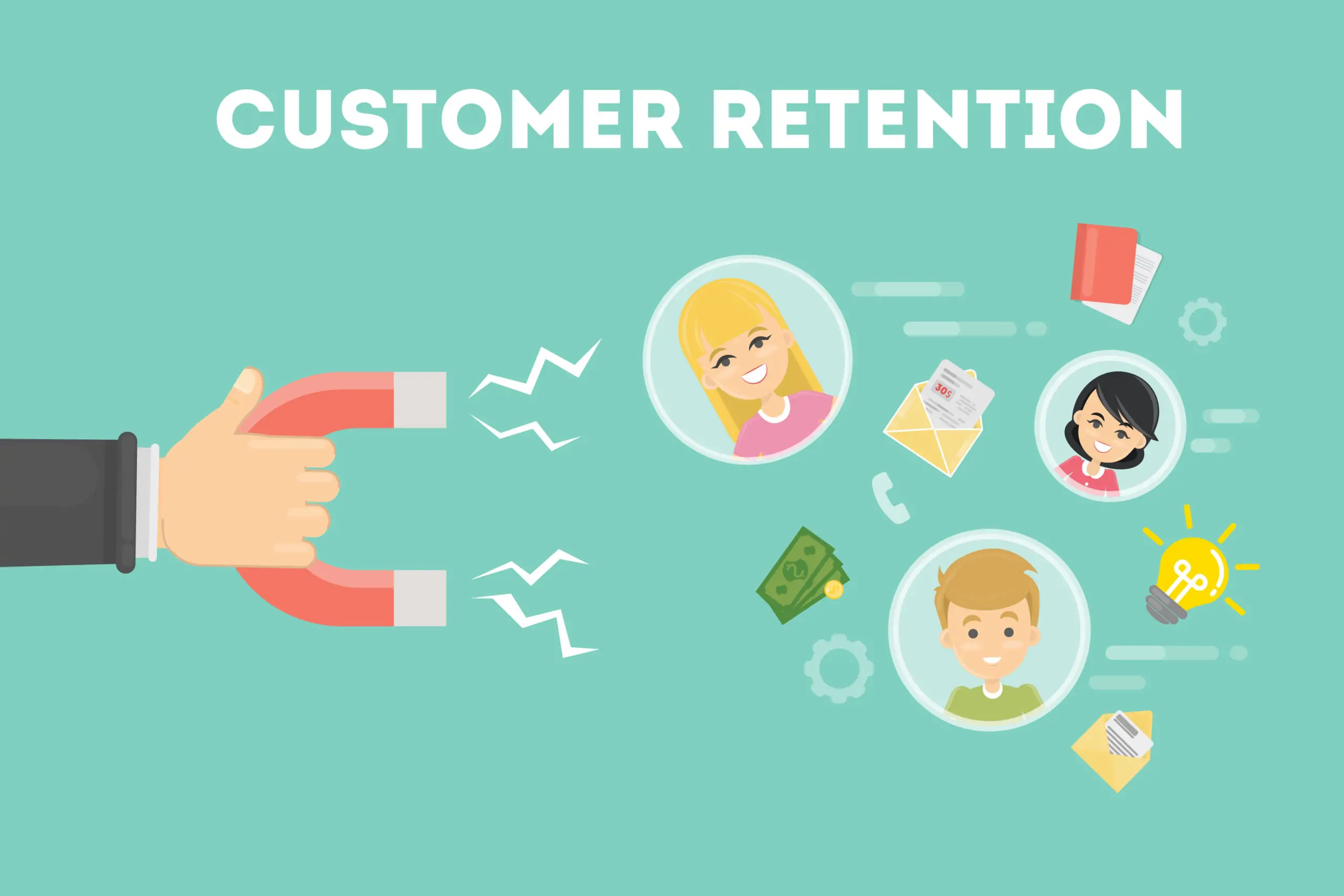What is Customer Retention?

Customer retention is all about making sure that the people who buy from you today will keep coming back tomorrow.
Imagine it like nurturing a friendship—if you want someone to stick around, you need to make them feel valued and appreciated. In business, this means consistently engaging with your customers, meeting their needs, and offering them value so they remain loyal to your brand.
Why is this so important? Because keeping your current customers happy is often much cheaper and more profitable than constantly trying to attract new ones.
If customers keep returning, it means they trust your brand, enjoy what you offer, and find value in sticking with you. In essence, customer retention is about building a loyal customer base that continues to choose your products or services over the competition.
Why Does Customer Retention Matter?
Think about it: when a customer is happy, they not only come back for more, but they also tend to spend more.
They might even tell their friends and family about your brand, bringing in new customers through word of mouth. These loyal customers are like gold—they’re not just buying from you; they’re also helping to grow your business by spreading the word.
Lets looks at some importance of customer retention now shall we,

- Lower Cost and Effort:
- Retaining customers is often more cost-effective than acquiring new ones. When you already have a relationship with a customer, you don’t need to spend as much on marketing, promotions, or outreach to keep them engaged.
The effort required to convince a new customer to try your product is significantly higher than encouraging an existing customer to make another purchase.
Over time, the reduced need for extensive marketing campaigns and sales efforts translates into lower overall costs for the company.
.
- Retaining customers is often more cost-effective than acquiring new ones. When you already have a relationship with a customer, you don’t need to spend as much on marketing, promotions, or outreach to keep them engaged.
- Increased Profitability:
- Loyal customers are more likely to spend more money with your business over time.
As they become more familiar with your products and trust your brand, they often make larger purchases, buy more frequently, and are willing to try additional products or services you offer.
This increased spending directly contributes to the bottom line, making customer retention a powerful driver of long-term profitability.
Additionally, the cost savings from retaining customers instead of acquiring new ones further enhances overall profitability.
.
- Loyal customers are more likely to spend more money with your business over time.
- Increased Publicity & Sales:
- Satisfied customers often turn into brand advocates. They’re likely to share their positive experiences with friends, family, and colleagues, effectively becoming a form of free marketing for your business.
This word-of-mouth publicity is incredibly valuable, as potential customers tend to trust personal recommendations more than traditional advertising.
The organic growth that comes from this kind of advocacy can lead to increased sales, as new customers are drawn to your brand based on the positive experiences of others.
.
- Satisfied customers often turn into brand advocates. They’re likely to share their positive experiences with friends, family, and colleagues, effectively becoming a form of free marketing for your business.
- Increased Scope for Innovation:
- A strong, loyal customer base provides a secure environment in which a business can innovate. Knowing that there is a core group of customers who already trust your brand makes it easier to introduce new products, services, or features.
These customers are more likely to be forgiving of any initial issues and provide valuable feedback that can help refine and improve new offerings.
This stable customer support allows a business to take calculated risks and pursue innovation with confidence, knowing they have a reliable audience to test and adopt new ideas.
.
- A strong, loyal customer base provides a secure environment in which a business can innovate. Knowing that there is a core group of customers who already trust your brand makes it easier to introduce new products, services, or features.
- Increased Scope for Innovation (Repeated):
- The repeated mention of this point emphasizes its importance. Customer retention not only supports innovation but also encourages it.
When you have a loyal customer base, you can experiment with new ideas, products, or services with a safety net in place. Loyal customers are more likely to engage with new offerings and provide constructive feedback, helping you to iterate and improve.
This constant feedback loop fuels innovation, enabling your business to evolve and stay competitive in the market.
.
- The repeated mention of this point emphasizes its importance. Customer retention not only supports innovation but also encourages it.
Customer retention is crucial for reducing costs, boosting profitability, and driving organic growth through customer advocacy.
It also creates a supportive environment for innovation, allowing businesses to continuously improve and introduce new products or services with the backing of a loyal customer base.
By focusing on retaining customers, businesses can ensure sustained success and growth in an increasingly competitive marketplace.
Beyond just repeat business, retained customers can become brand ambassadors. They share their positive experiences, write glowing reviews, and help build your reputation.
This organic promotion is invaluable, as it often carries more weight than traditional advertising. Plus, loyal customers tend to be less sensitive to price changes and more forgiving of occasional mistakes, making them even more valuable to your business.
How Can You Improve Customer Retention?
Keeping customers coming back is about building relationships that go beyond just transactions. It’s like maintaining a friendship—you need to show that you care, understand their needs, and are there for them. Here are some human-centered strategies to improve customer retention:
1. Personalized Marketing:
- Think about how much it means when someone remembers your favorite coffee order or how you like your tea. It makes you feel special, right? The same goes for customers.
When a business remembers what a customer likes and tailors its marketing to those preferences, it feels personal and considerate.
For instance, if a customer frequently buys a specific skincare product, sending them a personalized discount on that item not only shows that you’re paying attention but also makes them feel valued.
This kind of thoughtful marketing can make customers more likely to return because they know you understand their needs.
.
2. Loyalty Programs:
- Loyalty programs are like giving a friend a little reward for sticking by your side. It’s a way to say “thank you” for their ongoing support. Take a coffee shop.
For example, Offering a free drink after every ten purchases is a small but meaningful gesture that can make customers feel appreciated. This small token of gratitude can encourage them to keep coming back, knowing that their loyalty is recognized and rewarded.
It’s not just about the free drink—it’s about the feeling of being valued and recognized as a regular.
.
3. Exceptional Customer Service:
- Good customer service should feel like a warm, friendly conversation with someone who genuinely wants to help you. It’s about being proactive, attentive, and solving issues before they become big problems.
For instance, imagine a tech company offering 24/7 support. This shows customers that the company is always there for them, ready to help whenever needed. It’s like knowing a friend is always just a phone call away when you’re in a bind.
This level of care and support can turn a one-time buyer into a loyal customer who knows they can count on you.
.
4. Regular Engagement:
- Staying in touch with customers is like keeping in contact with a good friend. You don’t want to just disappear and only reach out when you need something. Regular engagement, whether through emails, newsletters, or social media, helps keep your brand at the forefront of their minds.
For example, a clothing brand might send out seasonal style tips or updates on new arrivals. This keeps customers interested and excited about what’s coming next. It’s about maintaining a relationship, not just making a sale.
By regularly reaching out, you’re showing that you care about their experience and want to keep them in the loop.
.
Improving customer retention is about more than just business tactics—it’s about treating your customers like valued individuals.
By personalizing your marketing, showing appreciation through loyalty programs, providing exceptional customer service, and staying regularly engaged, you can build lasting relationships.
These strategies help ensure that your customers feel valued and understood, making them more likely to stick around and continue doing business with you.
Customer Retention Metrics
To effectively gauge the success of customer retention efforts, organizations can track several key metrics.
These metrics provide valuable insights into the health of customer relationships and the effectiveness of retention strategies.
Here are five crucial metrics that can help businesses enhance their customer retention:
- Customer Churn Rate (CCR):
- Definition: This metric represents the percentage of customers who stop doing business with a company over a specific period.
. - Importance: A low CCR is desirable, as it indicates that fewer customers are leaving. The closer the CCR is to 0%, the better, as it suggests high customer satisfaction and loyalty. Companies with a low churn rate typically see a higher Customer Retention Rate (CRR).
.
- Definition: This metric represents the percentage of customers who stop doing business with a company over a specific period.
- Customer Lifetime Value (CLV):
- Definition: CLV is the projected revenue a company expects to earn from a customer throughout their entire relationship with the business.
. - Importance: This metric helps measure customer loyalty and the long-term profitability of individual customers.
By understanding CLV, businesses can identify strategies to maximize the return on investment (ROI) in marketing and customer support, ensuring that they focus on the most valuable customers.
.
- Definition: CLV is the projected revenue a company expects to earn from a customer throughout their entire relationship with the business.
- Customer Retention Rate (CRR):
- Definition: CRR indicates the percentage of customers a company retains over a specific period.
. - Importance: This metric is calculated by measuring the number of customers at the end of a period, subtracting new customers acquired during that time, and then dividing by the number of customers at the beginning of the period.
While a 100% CRR is ideal, this rate varies across industries. Increasing CRR is highly beneficial, as studies show that even a small improvement in retention can lead to a significant boost in profits, sometimes by more than 90%.
.
- Definition: CRR indicates the percentage of customers a company retains over a specific period.
- Net Dollar Retention (NDR):
- Definition: NDR measures the percentage of recurring revenue retained from existing customers over a set period.
. - Importance: NDR takes into account various factors that affect recurring revenue, such as downgrades, cancellations, and pause requests.
Because it reflects the true financial impact of customer retention, NDR is often considered a more accurate indicator of retention success compared to other revenue metrics like Monthly Recurring Revenue (MRR) and Annual Run Rate (ARR).
.
- Definition: NDR measures the percentage of recurring revenue retained from existing customers over a set period.
By tracking these metrics, businesses can gain a clearer understanding of how well they are retaining customers, identify areas for improvement, and implement strategies to foster long-term customer loyalty.
Customer Retention Strategies
Customer retention strategies are techniques and approaches that businesses use to keep their existing customers engaged, satisfied, and loyal over time.
Retaining customers is crucial for long-term business success because it is often more cost-effective to keep existing customers than to acquire new ones. Here are some key customer retention strategies:

- Overcome Buyers Remorse: This strategy involves addressing any feelings of doubt or regret a customer may have after making a purchase.
By providing reassurance, support, and validation, businesses can help customers feel confident in their decision, reducing the likelihood of returns or cancellations.
. - Loyalty Programs: These programs are designed to reward repeat customers. By offering points, discounts, or exclusive benefits, businesses can encourage customers to keep coming back.
Loyalty programs create a sense of value and appreciation, which can significantly increase customer retention.
. - Personal Touches: Adding a personal touch means customizing the customer experience to make each interaction feel unique and special.
This could involve personalized communications, remembering customer preferences, or offering tailored recommendations. Personal touches help build strong, emotional connections with customers.
. - Premiums & Gifts: This strategy involves offering gifts or special rewards to loyal customers. By surprising customers with unexpected bonuses, businesses can reinforce positive feelings and encourage continued loyalty.
Premiums and gifts can be a powerful way to show appreciation and stand out from competitors.
. - Questionnaires/Surveys: Regularly seeking feedback from customers through questionnaires or surveys allows businesses to understand their needs and preferences better.
By acting on this feedback, companies can improve their products and services, leading to higher customer satisfaction and retention.
. - Regular Reviews: Conducting regular reviews of customer experiences helps businesses stay proactive in addressing any issues or concerns.
By maintaining open lines of communication and checking in frequently, companies can ensure that customers remain satisfied and engaged.
.
Some Examples of Customer Retention
- Amazon Prime:
- Amazon has mastered the art of customer retention with its Prime program. By offering benefits like free shipping, exclusive deals, and access to streaming services, Amazon gives customers plenty of reasons to stick around and renew their membership year after year.
.
- Amazon has mastered the art of customer retention with its Prime program. By offering benefits like free shipping, exclusive deals, and access to streaming services, Amazon gives customers plenty of reasons to stick around and renew their membership year after year.
- Starbucks Rewards:
- Starbucks keeps customers coming back with its rewards program. Every time a customer makes a purchase, they earn points that can be redeemed for free drinks or food items. This not only encourages repeat visits but also builds a sense of loyalty and satisfaction.
.
- Starbucks keeps customers coming back with its rewards program. Every time a customer makes a purchase, they earn points that can be redeemed for free drinks or food items. This not only encourages repeat visits but also builds a sense of loyalty and satisfaction.
- Apple’s Ecosystem:
- Apple is a pro at keeping customers within its ecosystem. Once someone buys an iPhone, they’re likely to invest in other Apple products like the iPad, Apple Watch, or MacBook.
These products work seamlessly together, making it convenient for customers to stay with Apple rather than switch to another brand.
.
- Apple is a pro at keeping customers within its ecosystem. Once someone buys an iPhone, they’re likely to invest in other Apple products like the iPad, Apple Watch, or MacBook.
Final Thoughts
At its core, customer retention is about more than just making sales—it’s about building relationships. When you focus on making your customers feel valued and appreciated, you’re not just securing their next purchase; you’re creating a lasting connection that benefits both you and them.
By using strategies like personalized marketing, loyalty programs, exceptional customer service, and regular engagement, you can foster this loyalty, encourage repeat business, and set your company up for long-term success.
And finally if you want to grow and make your business succeed you need to have good customer retention.


![How to Use LinkedIn for Business [2025 Guide]](https://technaseer.com/wp-content/uploads/2025/02/download-300x156.png)

![How to Build a LinkedIn Marketing Strategy [Free Template]](https://technaseer.com/wp-content/uploads/2025/02/1696446402112-300x169.jpeg)

